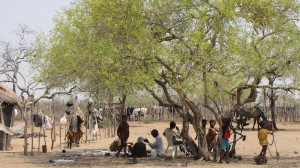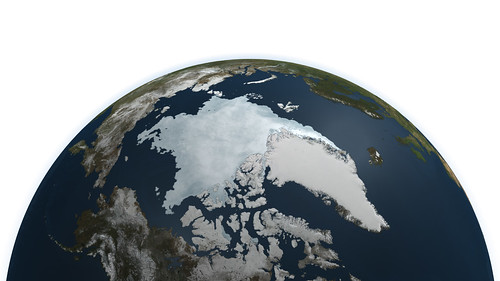An island running dry

Photo: S. Ferse, ZMT
Climate change is looming large in the island state of Indonesia, where rising sea levels pose a major risk. But it’s actually a different problem that might force inhabitants of the Spermonde archipelago lying off Southern Sulawesi to leave their islands: drinking water is running low, and the existing water quality is getting worse.
A team of German and Indonesian scientists is pointing to climate change as a major source of that problem. Many of the islands get their drinking water from a freshwater lens – a layer of drained rainwater that accumulates in the soil. Just one lens is about ten to twenty centimeters deep and covers a large part of the archipelago.
Because of climate change, the island region is expected to be face more and more extreme weather patterns, from droughts to severe rain. But the torrents of water that hit the earth during monsoon seasons don’t have enough time to seep into the soil. Instead, the lion’s share flows over the earth’s surface and into the ocean. And the growing amount of sealed surfaces make matters worse: because the area is densely populated, a lot of ground is covered by streets and buildings. Plus, heavy storms – expected to become more frequent – are washing seawater onto the islands and into wells.
Still, climate change is just partly to blame for the dwindling water resources. Since the beginning of 20th century, not only the number of inhabitants but also the demand for drinking water has doubled. As there are no rules preventing anyone from digging wells anywhere and no official limit on how much water may be drawn from them, many locals have dug wells themselves. But they have little knowledge of the soil’s properties or the freshwater lenses when pumping. And when salty water from deep below mixes with the fresh water near the surface, it becomes increasingly brackish – bad for people and the environment.
Arctic defrosting faster than ever
With the world expecting to celebrate world records at the London Olympics from today, the weather in recent weeks has delivered many high scores we should be less happy with: Record breaking high temperatures in the USA, droughts in Canada or deadly floods in Russia are just the most prominent examples.
Now there’s more. This summer, ice in arctic regions has been melting more extensively than ever seen before.
NASA scientists reported that in mid-July a whopping 97 percent of Greenland’s ice surface was melting. While the amount of surface melting can change extensively and in a matter of days (depending on the temperature of the air above), it’s never been observed to cover that large an area in more than 30 years of satellite observations.
Is this just a freak event or global warming in action? Scientists are careful not to draw a direct link between extreme weather events and climate change. For good reason: Some phenomena may not have been observed before, but scientists are not surprised to see them regardless of a global warming. Cores drilled out the Greenland ice sheets can help recover the temperature history for the place and indicate that extreme melting regularly occured every 150 years or so. This summer’s thawing episode is “right on time”, says one NASA glaciologist.
But the accumulation of extreme weather events is something you would plausibly expect under conditions of global warming, says Global Ideas climate expert Anders Levermann of the Potsdam Institute of Climate Impact Research. Even then, “we can’t say what the further impacts will be,” he cautions. In the case of Greenland “we don’t know what a period of extreme melting actually means except that in this moment more water is being lost and the water level is rising.”
Taking a long hard look at individual regions, however, can help establish more direct links between regional trends and global warming. At least 70 percent of the reduction of Arctic sea ice over the last 30 years may be man made suggests a study by a British-Japanese team of scientists. Here’s how the lead author puts it:
Namibia’s big discovery

Namibia’s government has made what looks to be a major discovery: a new aquifer that could be the answer to water shortages. One of the researchers on the discovery team is Martin Quinger, a project manager for the German Federal Institute for Geosciences and Natural Resources, told the BBC that the vast water deposit could supply northern Namibia for an incredible 400 years. And that is especially important for a country that is considered the driest in sub-Saharan Africa.
The aquifer, called Ohangwena II, straddles the border between Namibia and Angola, and Quinger says it could be as much as 10,000 years old…but don’t worry, the water is still fresh and safe to drink. As climate change brings around an increasing number of dry spells and drought, the water source is a major discovery.
A tricky question
Authors: Kerstin Schnatz and Philipp Bilsky, Camera-Operatpr: Philipp Bilsky
What if there was only one thing the world could do to stop climate change? Or at least to slow it down? What would be the most important step to take? How would you decide? That’s what we asked visitors at the Rio+20 Earth Summit, the United Nations Conference on Sustainable Development in Rio de Janeiro. Apparently a tricky question to answer.
How animation films arouse attention for climate protection
THE HEAT from Aufgeheizt on Vimeo.
Project Aufgeheizt (“heated-up”) brought together scientists and animation film experts with around 30 young people in Berlin aged 12 – 18 to make short films explaining the impacts of climate change. On 2nd June 2012, as part of the programme for “Der L ange Nacht der Wissenschaft” (The Long Night of Science) at Potsdam Institute for Climate Impact Research, seven films were premiered in a klimakino (“climate -cinema”) and the following films were honoured in a prize giving ceremony:
- Geoengineering – overall best film
- “Aufgeheizt und weggespült” for the best/funniest storyline
- “Hilfe, Wasser!” for the most original set design
- “The Heat” – for the best special effects
- “Weniger Regen? Von wegen!” for the best character development
- “Eisschelf – De-iced” for die best dramatisation
- “Nordatlantische Strömungen” for the best cut and symbolic representation
Aufgeheizt is a pilot project funded by VW Stiftung to help scientists improve their communication about climate change with the general public. Organisations wishing to find out about future projects should contact Katie Griggs: k.griggs@aufgeheizt.org (EN or DE)









Feedback